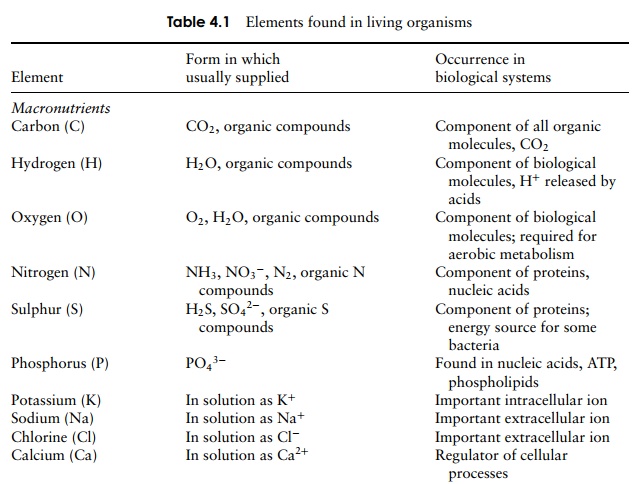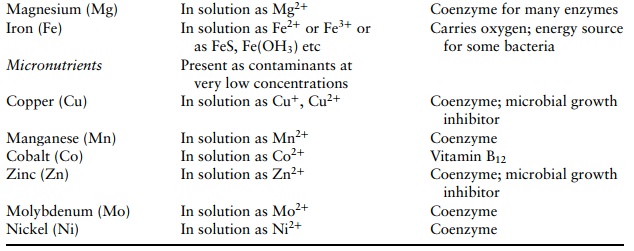Chapter: Essential Microbiology: Microbial Nutritionand Cultivation
Microbial Nutrition and Cultivation
Microbial Nutrition and
Cultivation
We
introduced the major groups of macromolecules found in living cells; the raw
materials from which these are synthesised are ultimately derived from the
organism’s environment in the form of nutrients (Table 4.1). These can be
conveniently divided into those required in large quantities* (macronutrients)
and those which are needed only in trace amounts (micronutrients or trace
elements).


You will
recall that carbon forms the central component of proteins, carbohydrates,
nucleic acids and lipids; indeed, the living world is based on carbon, so it
should come as no surprise that this is the most abundant element in all living
cells, microbial or other-wise. Of the other macronutrients, nitrogen, oxygen,
hydrogen, sulphur and phosphorus are also constituents of biological
macromolecules, while the remainder (magnesium, potassium, sodium, calcium and
iron in their ionised forms) are required in lesser quan-tities for a range of
functions that will be described in due course. Micronutrients are all metal
ions, and frequently serve as cofactors for enzymes.
All
microorganisms must have a supply of the nutrients described above, but they
show great versatility in the means they use to satisfy these requirements.
The
metabolic processes by which microorganisms assimilate nutrients to make cellular
material and derive energy will be reviewed. In the following sec-tion we
briefly describe the role of each element, and the form in which it may be
acquired.
Carbon
is the central component of the biological macromolecules. Carbon incorporated
into biosynthetic pathways may be derived from organic or inorganic sources ;
some organisms can derive it from CO2, while others require their
carbon in ‘ready-made’, organic form.
Hydrogen
is also a key component of macromolecules, and participates in energy
gen-eration processes in most microorganisms. In autotrophs (see ‘Nutritional
categories’ be-low), hydrogen is required to reduce carbon dioxide in the
synthesis of macromolecules.
Oxygen
is of central importance to the respiration of many microorganisms, but in its
molecular form (O2), it can be toxic to some forms. These obtain the
oxygen they need for the synthesis of macromolecules from water.
Nitrogen
is needed for the synthesis of proteins and nucleic acids, as well as for
important molecules such as ATP. Microorganisms range in their demands for
nitrogen from those that are able to assimilate (‘fix’) gaseous nitrogen (N2)
to those that require all 20 amino acids to be provided preformed. Between
these two extremes come species that are able to assimilate nitrogen from an
inorganic source such as nitrate, and those that utilise ammonium salts or urea
as a nitrogen source.
Sulphur
is required for the synthesis of proteins and vitamins, and in some types is
involved in cellular respiration and photosynthesis. It may be derived from sulphur-containing
amino acids (methionine, cysteine), sulphates and sulphides.
Phosphorus
is taken up as inorganic phosphate, and is incorporated in this form into
nucleic acids and phospholipids, as well as other molecules such as ATP.
Metals such as copper, iron and magnesium are re-quired as cofactors in enzyme reactions.

Many microorganisms are unable to synthesise certain organic
compounds necessary for growth and must therefore be provided with them in
their growth medium. These are termed growth
factors (Table 4.2), of which three main groups can be identified: amino
acids,purines and pyrimidines (required for nucleic acid synthesis) and
vitamins. You will al-ready have read about the first two of these groups..
Vitamins are complex organic compounds required in very small amounts for the
cell’s normal functioning. They are often either coenzymes or their precursors. Microorganisms vary greatly in their
vitamin requirements. Many bacteria are completely self-sufficient, while
protozoans, for example, generally need to be supplied with a wide range of
these dietary supplements. A vitamin requirement may be absolute or partial; an
organism may be able, for example, to synthesise enough of a vitamin to
survive, but grow more vigorously if an additional supply is made available to
it.
Related Topics